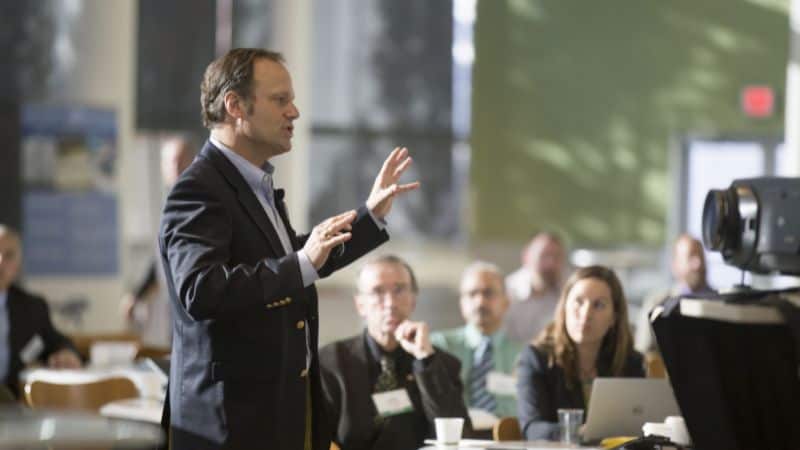It doesn’t matter if you’re a CEO in a boardroom, a teacher in front of restless students, or a parent trying to guide your child: leadership always requires storytelling.
Because when you lead, you are not just giving instructions. You are shaping vision. You are helping others see what you see, feel what you feel, and believe in what’s possible.
And here’s the truth: it will be easier to lead when you know how to tell a story.
More Than Words
Jeff Goins once said: “You have to help others see your story. Make them feel, taste, smell, and touch your story.”
Think about that. Most people share stories as if they are reading bullet points from a PowerPoint slide. They strip out the texture. They jump straight to the moral. They deliver words, but not worlds.
Leadership storytelling is different. It’s not about impressing with polished lines—it’s about immersing people in a real moment so they cannot help but see themselves inside it.
That’s why I always remind leaders: stories are not about what happened to you. Stories are about what happens in them.
The Whisper You Can’t Ignore
In Start With One Shift, I wrote about my early years as a teacher earning ₱6000 a month. At first, it felt like progress. But when I looked at the teachers ahead of me—those who had stayed in the game for decades—I saw my future. And I wasn’t sure I wanted it.
Most days, I drowned that whisper out. I stayed busy, I worked hard, I convinced myself that maybe this was enough. But late at night, when the noise faded, the whisper returned:
“There must be something else.”
That was the story beneath the story.
When I retell this moment to leaders, I don’t just share the facts. I bring them into the room. I describe the cramped faculty office. The smell of chalk dust. The tired faces of colleagues waiting for retirement. The quiet ache of knowing hard work alone wouldn’t set me free.
And suddenly, the room shifts. Because the leaders listening aren’t just hearing about my whisper. They’re hearing the whisper in their own hearts—the one they’ve been ignoring.
That’s the power of story. It mirrors the hidden struggles of others.
Starting Smaller Than You Think
Many leaders struggle because they try to inspire with grand visions alone. But people don’t move because of massive blueprints—they move because of relatable first steps.
In Start With One Shift, I tell the story of carrying small stones instead of the whole mountain. Early in my career, I thought I needed perfect timing, full plans, and massive courage before I could start. So I stayed busy preparing. Waiting. Pretending.
But momentum didn’t come from waiting. It came from launching imperfectly. Raising my fee by ₱500, not ₱50,000. Asking better questions after a workshop, not redesigning my whole system overnight.
When I share this story with leaders, I don’t just give them advice to “start small.” I make them see the scene: a speaker with ₱550 in his wallet, choosing to say no to the wrong client. I let them feel the anxiety, the doubt, the stubborn courage to choose differently.
And then I pause.
Because in that silence, many leaders realize: they’ve been carrying mountains on their backs, when all they needed was to move the first stone.
Stop Waiting. Launch Ugly.
One of the most freeing lessons I ever learned was this: perfection is procrastination in disguise.
In Start With One Shift, I tell the story of my first newsletter. It was messy. Unedited. A little embarrassing. But I sent it anyway.
And you know what happened?
People printed it. Shared it. Wrote me letters of gratitude. One manager even compiled the issues into a book for his team. That ugly newsletter led to workshops, partnerships, and long-term clients.
The newsletters I kept perfecting? They did nothing. They sat in drafts, invisible.
This story always makes leaders smile—because they recognize themselves. They have projects sitting in folders, speeches stuck in drafts, ideas waiting for polish.
And when they see me laugh about my ugly launches, they feel permission to launch their own.
That’s what stories do: they break the chains of perfection by proving that messy beginnings are often the real breakthroughs.
Why Leaders Need to Tell Stories
When you lead with numbers, people nod. When you lead with logic, people might agree. But when you lead with stories, people move.
Because stories:
- Mirror hidden struggles. They make people feel seen.
- Reveal small shifts. They show what’s possible without overwhelming.
- Create permission. They give others courage to act imperfectly.
That’s why telling stories isn’t just a “nice” leadership skill. It’s your most practical tool for multiplying influence.
The Practice That Makes You a Story-Maker
Here’s the secret: reading books on storytelling won’t make you a storyteller.
You can highlight tips from Jeff Goins, Donald Miller, or Nancy Duarte. You can watch TED Talks and listen to podcasts. But the only way to truly become a story-maker is to actually tell stories to people.
Not once. Not twice. Repeatedly.
Every story is a rehearsal. Every telling sharpens the beats, the pauses, the details. And every reaction teaches you what lands, what falls flat, and what moves people.
That’s why I always remind leaders:
👉 Whatever you learn about storytelling, apply it at once.
Tell a story to a colleague. Share it with your team. Test it in a meeting.
Because you don’t become excellent at stories by studying. You become excellent by telling them.
Small Shifts to Build Your Storytelling Muscle
From Start With One Shift, here are three tiny experiments you can try:
- Catch the Win (Book 2, Chapter 13). At the end of each day, write down one small story of progress you saw in yourself or your team. Share one tomorrow. Small wins make big stories.
- Ask Three Before You Answer One (Book 3, Chapter 11). When someone brings you a challenge, don’t give advice immediately. Ask three questions first. Their answers become raw material for stories that matter.
- Launch Ugly (Book 3, Chapter 12). Tell a story even if it’s rough. Don’t wait until you have the perfect opening or polished punchline. Speak it, learn from it, refine it.
These aren’t theory. They are daily storytelling drills that make leadership lighter and more human.
The Shift in You
If you take one thing from this, let it be this: your story is already good enough.
You don’t need to invent dragons or fireworks. You only need to tell the truth in a way that people can feel.
Because leadership is not about giving people answers. It’s about giving them courage. And nothing gives courage faster than a story that says: “I’ve been there too. And here’s what shifted.”
So start today. Tell one story—ugly, simple, unfinished if it has to be. Watch how people lean in. Watch how the room softens.
And then, keep telling. Keep practicing. Keep making stories until they move others as naturally as they move you.
Because it will always be easier to lead when you know how to tell a story.







5